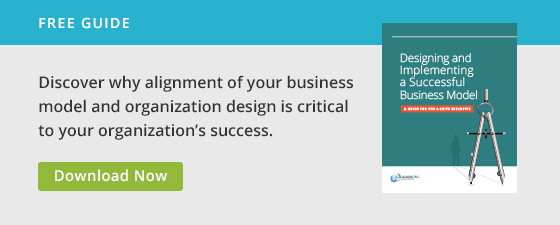In theory, if you put a diverse group of people together, they will think diverse thoughts. They will be creative, they will be additive to one another, and they will ultimately come up with a better solution, because the sum of the parts will be greater than any one part. But unfortunately, good decision making doesn’t always happen in a team setting.
Much of the time, organization design and change management work is best approached as a team effort. At AlignOrg Solutions, we do a lot of our work with design teams, whether we are working with a leadership team in a company, or putting together cross-functional teams to accomplish transformational change. We do this because as the old saying goes, two (or more) heads are better than one: we believe that a well-functioning team is more likely than an individual to make the best decisions about how the organization might need to change in order to drive strategy or to transform.
5 Traits of a Good Decision Making Team
We are all familiar with the classic cases of group think. People sometimes adopt a particular way of thinking, and instead of challenging it they pursue it despite evidence to the contrary.
When we put together a team, the hope is that constructive, positive, additive energy can come from it. To increase the likelihood of this happening, those who are facilitating teams or groups to make decisions need to keep a few things in mind:
- Diversity. As you are assembling your team, look at the composition of the group. Do you have diversity of experiences, diversity of backgrounds and diversity of thought?
- Loyalty. As you assemble a team, have you assembled people who have the ability to suspend their own interest to think about what is best for the organization? Will the individuals you include think about the good of the organization and about the overarching objectives or problems that needs to be solved?
- Open-mindedness. Are team members open to and accepting of contrarian points of view? Do they use these contrary viewpoints to challenge their own assumptions to come up with creative solutions?
- Courage. Is there someone on the team who is willing and/or able to be the contrarian? To ask tough questions, to pose alternative scenarios or ideas, to challenge the current thinking and assumptions of the group?
- Inclusive process. Is there a good decision making process that allows for dissenting opinions to be heard and for all to feel like they are helping shape the future direction?
Leveraging Diversity Through Process
The concept of an inclusive process merits a closer look, because even a strong team will not make the best decisions if the process doesn’t support it. We have a simple approach we often use when facilitating decision making in teams.
Imagine we’re in a group trying to make a decision around something and there’s been tension around what’s the best thing to do: should we go left or right? Perhaps we start to land on going left. We will say to the group, “Put your thumb up if you absolutely think we ought go left, hold it sideways if you are not wholly behind it but are willing to support it, and put your thumb down if you think it’s absolutely the wrong thing to do.” Then everyone can look around the room and see who’s got their thumb up, who’s got it sideways and if anyone has put their thumb down.
At that point, if anyone has put their thumb down, we can say “Let’s stop for a minute and hear why this person doesn’t think going left makes any sense at all, and why they have a hard time supporting it.” Once they’ve had a chance to explain their viewpoint, the team can always say “Thanks for your contrarian opinion, but we disagree, and the majority is going to trump you.” However, if you take the time to hear that voice it is amazing how many times a group’s thinking will completely change. They may decide that going right was really the best decision, not left. Or, they’ll say, “You know what, you’ve raised a really good point. We were planning to go left and we’re still going to go left, but we’re going to do it a little differently than we were planning because you raised an issue for us that’s important and that we want to consider.”
Good Decision Making is a Strategic Choice
Whether you are working with an Agile team, an organization design team, a strategy setting team, or any other group making high-stakes organization design and/or strategy decisions, it is critical to both assemble the right team and to have a process that will support them. Using the five tactics outlined above will help to make sure that your team will not just fall into line and make adequate decisions, but really make the best decisions for your organization.






